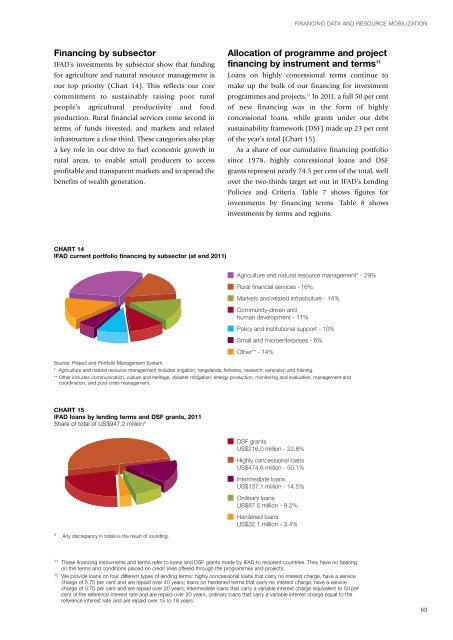ANNUAL REPORT 2011 - IFAD
ANNUAL REPORT 2011 - IFAD
ANNUAL REPORT 2011 - IFAD
Create successful ePaper yourself
Turn your PDF publications into a flip-book with our unique Google optimized e-Paper software.
Financing by subsector<br />
<strong>IFAD</strong>’s investments by subsector show that funding<br />
for agriculture and natural resource management is<br />
our top priority (Chart 14). This reflects our core<br />
commitment to sustainably raising poor rural<br />
people’s agricultural productivity and food<br />
production. Rural financial services come second in<br />
terms of funds invested, and markets and related<br />
infrastructure a close third. These categories also play<br />
a key role in our drive to fuel economic growth in<br />
rural areas, to enable small producers to access<br />
profitable and transparent markets and to spread the<br />
benefits of wealth generation.<br />
CHART 14<br />
<strong>IFAD</strong> current portfolio financing by subsector (at end <strong>2011</strong>)<br />
CHART 15<br />
<strong>IFAD</strong> loans by lending terms and DSF grants, <strong>2011</strong><br />
Share of total of US$947.2 million a<br />
FINANCING DATA AND RESOURCE MOBILIZATION<br />
Allocation of programme and project<br />
financing by instrument and terms11 Loans on highly concessional terms continue to<br />
make up the bulk of our financing for investment<br />
programmes and projects. 12 In <strong>2011</strong>, a full 50 per cent<br />
of new financing was in the form of highly<br />
concessional loans, while grants under our debt<br />
sustainability framework (DSF) made up 23 per cent<br />
of the year’s total (Chart 15).<br />
As a share of our cumulative financing portfolio<br />
since 1978, highly concessional loans and DSF<br />
grants represent nearly 74.5 per cent of the total, well<br />
over the two-thirds target set out in <strong>IFAD</strong>’s Lending<br />
Policies and Criteria. Table 7 shows figures for<br />
investments by financing terms. Table 8 shows<br />
investments by terms and regions.<br />
Agriculture and natural resource management* - 29%<br />
Rural financial services - 16%<br />
Markets and related infrastruture - 14%<br />
Community-driven and<br />
human development - 11%<br />
Policy and institutional support - 10%<br />
Small and microenterprises - 6%<br />
Other** - 14%<br />
Source: Project and Portfolio Management System.<br />
* Agriculture and natural resource management includes irrigation, rangelands, fisheries, research, extension and training.<br />
** Other includes communication, culture and heritage, disaster mitigation, energy production, monitoring and evaluation, management and<br />
coordination, and post-crisis management.<br />
a<br />
Any discrepancy in totals is the result of rounding.<br />
DSF grants<br />
US$216.0 million - 22.8%<br />
Highly concessional loans<br />
US$474.6 million - 50.1%<br />
Intermediate loans<br />
US$137.1 million - 14.5%<br />
Ordinary loans<br />
US$87.5 million - 9.2%<br />
Hardened loans<br />
US$32.1 million - 3.4%<br />
11 These financing instruments and terms refer to loans and DSF grants made by <strong>IFAD</strong> to recipient countries. They have no bearing<br />
on the terms and conditions placed on credit lines offered through the programmes and projects.<br />
12 We provide loans on four different types of lending terms: highly concessional loans that carry no interest charge, have a service<br />
charge of 0.75 per cent and are repaid over 40 years; loans on hardened terms that carry no interest charge, have a service<br />
charge of 0.75 per cent and are repaid over 20 years; intermediate loans that carry a variable interest charge equivalent to 50 per<br />
cent of the reference interest rate and are repaid over 20 years; ordinary loans that carry a variable interest charge equal to the<br />
reference interest rate and are repaid over 15 to 18 years.<br />
63

















